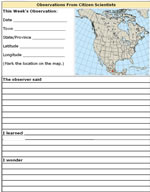Teaching
Suggestions
Reading and Reflecting on Observation Reports from Citizen Scientists
How to Use the Journal Page in Your Classroom
Take advantage of the observation reports that other student
and adult citizen scientists have submitted. Students can use the journal
page (right) to collect information from the reports and add their thoughts,
discoveries, calculations, predictions, and questions. Here are some core
questions:
- What scientific data can we collect from each report? How can we tell facts from opinions?
- Which reports have the details we need to document monarch migration rates? What information is missing?
- What questions would we like to ask these citizen scientists?
1. Find
an interesting migration sighting
Ask each student to select a sighting that was submitted by a
citizen scientist. You'll find a collection of sightings in each week's
migration update. Here are quick links to the weekly collections, on a
page that you can print or display:
| Aug. 27 | Sep. 24 (not done) | Oct. 22 |
| Sep. 3 | Oct. 1 (not done) | Oct. 29 |
| Sep. 10 | Oct. 8 | Nov. 5 |
| Sep. 17 | Oct. 15 |
You can also find all observations as raw data in the sightings database and on the migration maps.
2. Have each student use the journal page to record an excerpt and collect his or her thoughts about the sighting. Students should do this:
- Record the date, location of observation (town/state/province), and global address (latitude and longitude).
- Use the map to mark the location of the sighting.
- Revisit the observation report. Collect information and data to comment on; copy or paraphrase excerpts.
- Write about their discoveries, questions, predictions, personal connections, and opinions.
3. Share these reflections in small groups or as a class.
4. Build
a journal throughout the season. Encourage students to add these
completed pages to their journals.
Assessment note: You and students can also use the journal pages
to assess their emerging understanding. Read student reflections together
and discuss their thinking. Or collect the booklet or pages periodically
and use Post-it Notes for your comments.
Journal Page
Observation Reports
from Citizen Scientists
Try
This!
Check out "The
Data Hunt Challenge" to help students read and explore observation
reports.




